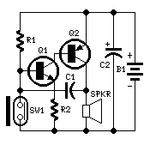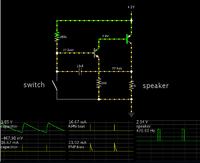geo_18
Newbie level 5
Dear friends,
Please help me to understand the working of the simple circuit i have attached here.

Here Q1 - BC547 and Q2 - BC 327.
R1 = 300k ohm, R2 = 100 ohm, C2 = 100 uF, C1 = 10nF. The battery used is 3Volts.
This is the circuit of a personal alarm. When the switch turns open, the speaker sounds aloud.
I would like to know how the speaker sounds when the switch turns open and how the capacitors aid in the working of this circuit. Also, is there any difference between the working of the pnp and npn transistors??
Please do help me soon.
Please help me to understand the working of the simple circuit i have attached here.

Here Q1 - BC547 and Q2 - BC 327.
R1 = 300k ohm, R2 = 100 ohm, C2 = 100 uF, C1 = 10nF. The battery used is 3Volts.
This is the circuit of a personal alarm. When the switch turns open, the speaker sounds aloud.
I would like to know how the speaker sounds when the switch turns open and how the capacitors aid in the working of this circuit. Also, is there any difference between the working of the pnp and npn transistors??
Please do help me soon.
Last edited:
